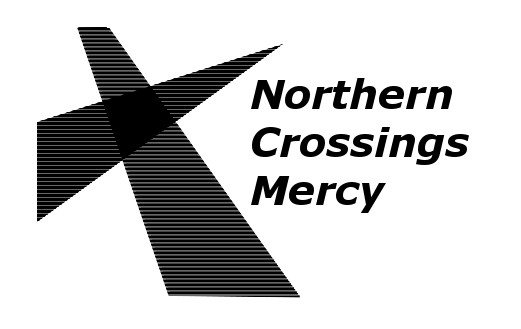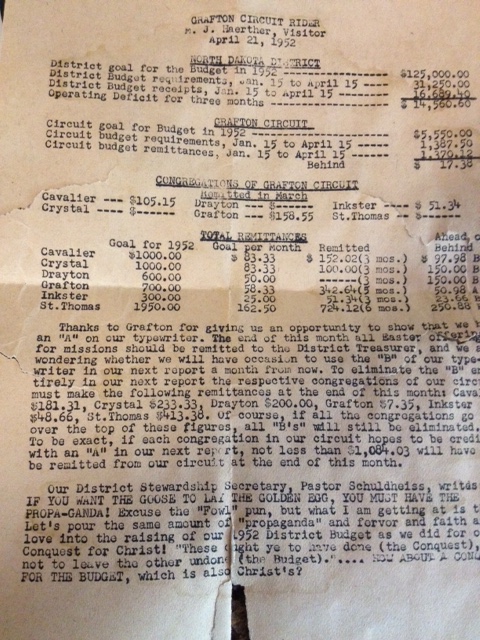The paper is literally disintegrating. It is a letter from the Grafton circuit rider Rev. M.J.Haerther. It was written on 21 April 1952 several months before I was born. Not only is it fascinating because of the way it was written; on a typewriter and obviously mimeographed. It is interesting because of the fact it was written the year I was born. The contents are extremely fascinating.
The top of the letter shows the North Dakota District goal for a budget of $125,000 and then it continues to break out the district budget requirements for three months, the district receipts for three months, and the operating deficit which was $14,560. It then explains what the goal for the Grafton circuit was for the entire year and that was $5550. Now at that time the Grafton circuit consisted of six congregations, Our Saviors in Cavalier, St. John in Crystal, Trinity in Drayton, Zion English in Grafton, a church in Inkster that no longer exists, and St. Paul's in St. Thomas. Each congregation is assessed an amount that is its goal not only for the year but for the month. Our Saviors Cavalier was assessed $1000 St. John's in Crystal was assessed $1000, Trinity in Drayton $600, Zion English in Grafton $700, whatever the name of the church in Inkster they were assessed $300 and St. Paul's in St. Thomas was assessed $1950. It then shows the goal per month and how much was given over three months and how far behind or ahead they were in their assessment.
Anyone who knows me knows I am not a mathematical type of person. But it seems to me what is happening here is the district budget is set and then congregations are assessed their fair share of that budget based on communicant membership. I know for a fact in 1952 St. Paul's in St. Thomas was the largest church in the Grafton circuit. It is assessed almost twice as much as any other congregation in that circuit. The point I'm trying to make here is that in the period of the greatest expansion of the Lutheran Church Missouri Synod, congregations were being assessed for the district work plan. I don't know this for a fact and I hope someone can enlighten us, but I'm assuming the districts were assessed for the work plan of Synod. What is even more interesting is obviously someone out there took the time to not only know what the congregational assessments were, but how much or how little they remitted each month. Back in the days before there was email, and Twitter, these men were writing letters to congregations and telling them, "this is how far behind or how far ahead you are in your fair share of what the district budget is".
Towards the end of the letter the district stewardship secretary, a gentleman by the name of Pastor Schuldheiss is quoted as hoping that the district put the same amount of fervor and faith and love into the raising of the district budget as they did for the 'Conquest for Christ'. He goes on to say "these you should have done (the Conquest) and not to leave the other undone (the budget). So in my opinion that even though they call giving to the district budget their mission, the real mission that they were working on was something called Conquest for Christ and I would like to find out more about what that was.
My point is that I believe we need to start assessing congregations on a fair share basis for the budget of Districts. Synod needs to assess Districts on a fair share basis for the budget of Synod. The understanding is these assessments are the cost of doing business in order that we can be equipped with the fervor, faith and love to go out and do real mission work which was back in 1952 called the "Conquest for Christ". We might collect for World Mission work or World Relief and Human Care Projects or whatever or gift of alms might be, but that is separate from the budget of the church at large.
I have asked on these pages before for comments on this issue. I don't see as much opposition from people when I talk about it as I thought there would be but I think we need to have a serious discussion about these issues soon because the days are coming when Synods and Districts will simply no longer be able to operate the way they have in the past. Why did we stop doing what we were doing in 1952?


